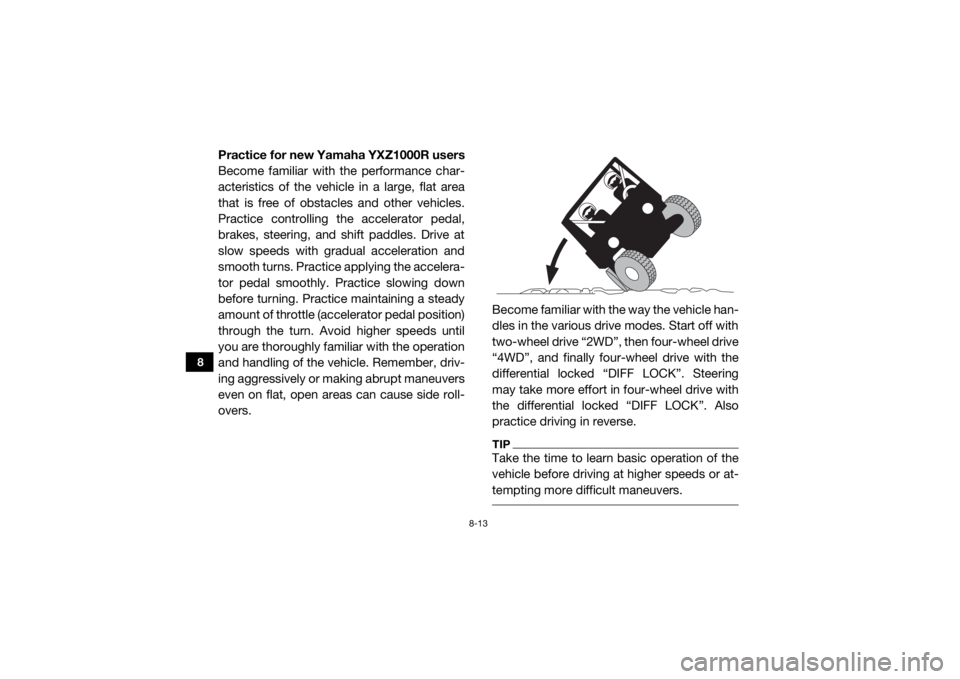steering YAMAHA YXZ1000R SS 2020 Owner's Manual
[x] Cancel search | Manufacturer: YAMAHA, Model Year: 2020, Model line: YXZ1000R SS, Model: YAMAHA YXZ1000R SS 2020Pages: 212, PDF Size: 9.36 MB
Page 115 of 212

8-10
8
Seat and shoulder bolsters
The seats and shoulder bolsters are designed
to help keep you in the vehicle. Do not put
your hand or arm on or outside of the shoul-
der bolster during operation. Your hand or
arm may be struck by objects or crushed
against outside objects or the ground during
a rollover.Floorboard
The floorboard allows you to brace your feet,
which helps you keep your body in the vehicle
in the event of an accident or rollover. Keep
your feet on the floorboard during operation.
Steering wheel
Keep both hands on the steering wheel. Do
not hold the steering wheel with your thumbs
inside the rim. Keep your palms on the out-
side of the steering wheel. Similar to other off-
road vehicles, if the YXZ1000R hits a deep rut
or large obstacle, the steering wheel could1. Wire loop
1
UBAS7AE0.book Page 10 Wednesday, June 19, 2019 11:51 AM
Page 116 of 212

8-11
8
briefly jerk in one direction or back and forth
as the tires and vehicle respond to the obsta-
cle. This quick motion could injure your
thumbs or wrist if your thumbs or hand(s) are
inside the steering wheel. Grip the steering
wheel so that your thumbs will not be hit by
the spokes. As an example, see the illustra-
tion.
CORRECT GRIP EXAMPLE
INCORRECT GRIP EXAMPLE
UBAS7AE0.book Page 11 Wednesday, June 19, 2019 11:51 AM
Page 118 of 212

8-13
8
Practice for new Yamaha YXZ1000R users
Become familiar with the performance char-
acteristics of the vehicle in a large, flat area
that is free of obstacles and other vehicles.
Practice controlling the accelerator pedal,
brakes, steering, and shift paddles. Drive at
slow speeds with gradual acceleration and
smooth turns. Practice applying the accelera-
tor pedal smoothly. Practice slowing down
before turning. Practice maintaining a steady
amount of throttle (accelerator pedal position)
through the turn. Avoid higher speeds until
you are thoroughly familiar with the operation
and handling of the vehicle. Remember, driv-
ing aggressively or making abrupt maneuvers
even on flat, open areas can cause side roll-
overs.Become familiar with the way the vehicle han-
dles in the various drive modes. Start off with
two-wheel drive “2WD”, then four-wheel drive
“4WD”, and finally four-wheel drive with the
differential locked “DIFF LOCK”. Steering
may take more effort in four-wheel drive with
the differential locked “DIFF LOCK”. Also
practice driving in reverse.
TIPTake the time to learn basic operation of the
vehicle before driving at higher speeds or at-
tempting more difficult maneuvers.
UBAS7AE0.book Page 13 Wednesday, June 19, 2019 11:51 AM
Page 119 of 212

8-14
8
Getting ready to ride
Perform the pre-operation checks on page
6-1. Follow the instructions on page 7-2 when
starting the engine.
Turning
Use care in turns — turning the steering wheel
too far or too fast can result in loss of control
or a rollover. Slow down before entering
turns. When making tight turns from a stand-
still or at slow speeds, avoid sudden or hard
acceleration. Driving aggressively or making
abrupt maneuvers even on flat, open areas
can cause side rollovers. Avoid sideways slid-
ing, skidding, or fishtailing (rear-wheel slid-
ing), and never do donuts. If you feel the
vehicle begin to slide sideways or the rear
wheels begin to slide during a turn, steer into
the direction of the slide, if possible, and
gradually let off the accelerator pedal to re-
gain directional control and avoid rollover. For
example, if you feel the back of the vehicle
start to slide to your right, steer to the right. If you think or feel that the vehicle may tip or
roll, keep your body completely inside the
protective structure of the vehicle:
Brace yourself by pressing your feet firmly
on the floorboard and keep a firm grip on
the steering wheel or passenger handhold.
Do not put your hands or feet outside of the
vehicle for any reason. Do not try to stop a
tipover using your arm or leg.
Accelerating
Avoid higher speeds and sudden or hard ac-
celeration until you are thoroughly familiar
with the operation of your vehicle. Avoid sud-
den or hard acceleration in any turn. Never
drive faster than is safe for current conditions.
Shifting
Follow the instructions on pages 7-2 and 7-3
for shifting, downshifting, and shifting into re-
verse until you are thoroughly familiar with
each operation.UBAS7AE0.book Page 14 Wednesday, June 19, 2019 11:51 AM
Page 121 of 212

8-16
8
Parking on a slope
The parking brake is located on the rear drive
shaft. When the drivetrain is in “2WD” mode,
only the rear wheels will be locked. Therefore,
switch the drive mode to “DIFF LOCK” before
stopping the engine to lock all four wheels
when parking. In addition to the parking
brake, leave the transmission in gear to help
prevent the vehicle from rolling.
If you park on a hill that is too steep, the vehi-
cle may roll out of control. Never park on hills
that are so steep you cannot walk up them
easily. If you must park on an incline, follow
these instructions:1. First, bring the vehicle to a stop and con- tinue to apply the brake pedal.
2. Switch the drive mode to “DIFF LOCK”
and shift into first gear when parking up-
hill, or reverse gear when parking down-
hill.
TIPYou may need to turn the steering wheel left
and right to help the differential lock into pla-
ce. 3. Stop the engine (turn the key to “ ”[off]).
4. With the brake pedal still being applied, set the parking brake.
5. Finally, get out of the vehicle and block
the front and rear wheels with rocks or
other objects.
Loading
Be aware that vehicle load includes the total
combined weight of the operator, passenger,
any installed accessories, and any luggage or
cargo brought on board or stored in the cargo
bed. Make sure that the gross vehicle weight
(vehicle load plus weight of the vehicle itself)
never exceeds 1065 kg (2348 lb).
UBAS7AE0.book Page 16 Wednesday, June 19, 2019 11:51 AM
Page 123 of 212

8-18
8
sense and remember that some hills are too
steep for you to climb or descend. Use proper
driving techniques to avoid rearward, for-
ward, or sideways rollovers on hills and
slopes.
Drive straight up and down inclines, not
across them. If crossing a hill is unavoidable,
drive slowly. Turn downhill immediately if you
feel the vehicle may tip.
If you think or feel the vehicle may tip or
roll:
Brace yourself by pressing your feet firmly
on the floorboard and keep a firm grip on
the steering wheel or passenger handhold.
Do not put your hands or feet outside of the
vehicle for any reason.
Uphill
Do not attempt to climb hills until you have
mastered basic maneuv ers on flat ground.
Drive straight up hills, and avoid crossing the
side of a hill, which increases your risk of roll- over. Practice first on gentle slopes before at-
tempting steeper hills. Always check the
terrain carefully before attempting any hill.
To climb a hill, you need traction, momentum,
and steady throttle. For more traction and
control for climbing steeper and/or rougher
slopes, shift into low gear and select “4WD”
or “DIFF LOCK”. Travel fast enough to main-
tain momentum, but not so fast that you can-
not react to changes in the terrain as you
climb.
Slow down when you reach the crest of the
hill if you cannot see clearly what is on the
other side – there could be another person, an
obstacle, or a sharp drop-off.
If you start to lose traction or momentum
when climbing, and decide you will be unable
to continue, use the brakes to stop. Do not at-
tempt to turn the vehicle around. With your
foot on the brake pedal, look behind you and
plan your descent. Shift the transmission into
reverse so you can use engine braking to
slow your descent. Release the brake, andUBAS7AE0.book Page 18 Wednesday, June 19, 2019 11:51 AM
Page 135 of 212

9-8
9
14*Wheels • Check balance, runout, and for damage.
• Balance wheel if necessary.
• Replace wheel if damaged or if runout is
over specified limits. √√√√
• Check and tighten the bead lock (for equipped models). Every 500 km (300 mi)
15 *Wheel bearings • Check bearing assemblies for loose-
ness/damage.
• Replace if damaged. √√√√
16 *Front and rear
suspension • Check operation and for oil leakage.
• Correct if necessary.
√√
17 *Steering system • Check operation and for looseness. Replace
if damaged.
• Check toe-in. Adjust if necessary. √√√√√
18 *Stabilizer bushes • Check for cracks or other damage, and re-
place if necessary. √√√
19 *Upper and lower
arm pivots • Lubricate with lithium-soap-based grease.
√√√
20 *Rear knuckle up-
per and lower piv-
ots • Lubricate with lithium-soap-based grease.
√√√
NO. ITEM ROUTINE
INITIAL EVERY
Whichev- er comes first month 1 3 6 6 12
km
(mi) 240
(150) 1300
(800) 2500
(1600) 2500
(1600) 5000
(3200)
hours 20 80 160 160 320UBAS7AE0.book Page 8 Wednesday, June 19, 2019 11:51 AM
Page 184 of 212

9-57
9
EBU32600Steering shaft lubricationLubricate the pivot points.
EBU32610Wheel removal1. Loosen the wheel nuts.
2. Elevate the vehicle and place a suitablestand under the frame.
3. Remove the nuts from the wheel.
4. Remove the wheel.
Recommended lubricant: Lithium-soap-based grease
Recommended lubricant: Lithium-soap-based grease
UBAS7AE0.book Page 57 Wednesday, June 19, 2019 11:51 AM
Page 211 of 212

13-3
13
Steering, Pre-operation check ....................................... 6-7
Steering shaft, lubrication ............................................ 9-57
Steering wheel position ............................................... 5-27
Storage ........................................................................ 10-2
Storage compartments ................................................ 5-29TTire, replacing .............................................................. 9-58
Tires, Pre-operation check ............................................ 6-8
Transmission oil ........................................................... 9-29
Transmission, Pre-operation check ............................... 6-6
Troubleshooting ........................................................... 9-69
Troubleshooting charts ................................................ 9-70UUpper and lower arm pivot, lubrication ....................... 9-55VValve clearance ............................................................ 9-47
Vehicle identification number ........................................ 1-1WWheel installation ......................................................... 9-59
Wheel removal ............................................................. 9-57YYamalube ..................................................................... 9-28
YCC-S clutch ............................................................... 9-51
YCC-S clutch, Pre-operation check .............................. 6-8
YCC-S system ............................................................. 5-23
YCC-S system warning light .......................................... 5-7
UBAS7AE0.book Page 3 Wednesday, June 19, 2019 11:51 AM